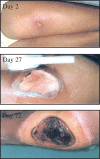Medical management of acute radiation syndrome and associated infections in a high-casualty incident
- PMID: 29509947
- PMCID: PMC5941165
- DOI: 10.1093/jrr/rry004
Medical management of acute radiation syndrome and associated infections in a high-casualty incident
Abstract
A high-casualty incident may result in a significant human toll due to the inability of a community to meet the health care demands of the population. A successful medical response requires health care facilities to not only communicate and integrate medical services, meet surge capacity, protect health care workers and implement triage and treatment protocols, but also to provide the venue for clinical management of acute radiation injuries and their associated infections. Today, clinical management is primarily guided by the recommendations of a Consultancy that were made at the World Health Organization (WHO). This international consensus was reached on evidence-based, clinical management of each of the four sub-syndromes that compose acute radiation syndrome (ARS), including the hematopoietic subsyndrome (HS), gastrointestinal subsyndrome (GIS), neurovascular subsyndrome (NVS) and cutaneous subsyndrome (CS). Major findings in studies meeting inclusion criteria for management strategies for HS were that (i) no randomized controlled studies of medical countermeasures have been (or will likely ever be) performed for ARS cases, (ii) the data for management of HS are restricted by the lack of comparator groups, and (iii) reports of countermeasures for management of injury to non-hematopoietic organs are often incompletely described. Here, (i) recommendations made in Geneva are summarized; (ii) the analysis of countermeasures for HS is updated by review of two additional cases and extended to published reports not meeting inclusion criteria; and (iii) guidelines are provided for management of microbial infections based upon patient risk for prolonged immunosuppression.
Figures





References
-
- Waselenko JK, MacVittie TJ, Blakeley WF et al. . Medical management of the acute radiation syndrome: recommendations of the Strategic National Stockpile Radiation Working Group. Ann Intern Med 2004;140:1037–51. - PubMed
-
- Coleman CN, Weinstock DM, Casagrande R et al. . Triage and treatment tools for use in a scarce resources-crisis standards of care setting after a nuclear detonation. Disaster Med Public Health Prep 2011;5:S111–21. - PubMed
-
- Albanese J, Skudlarska B, Smith D et al. . Impact of mass casualties resulting from radiation exposure on healthcare systems In: Nriagu JO. (Ed). Encyclopedia Environmental Health, Vol. 3 New York: Elsevier, 2011, 165–77.
-
- Rad Resilient City. A local planning tool to save lives following a nuclear detonation. Center for Biosecurity of UPMC, Baltimore, Maryland, 2011, www.radresilientcity.org (July 20 2017, date last accessed).
MeSH terms
Substances
LinkOut - more resources
Full Text Sources
Other Literature Sources
Medical

